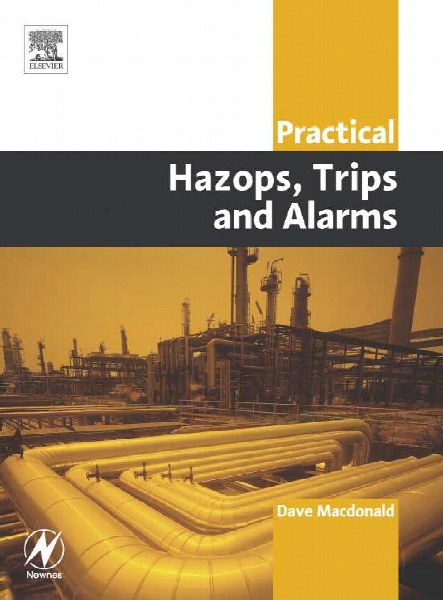Practical hazops, trips and alarms
- نوع فایل : کتاب
- زبان : انگلیسی
- مؤلف : Dave Macdonald
- ناشر : Amsterdam : Newnes/Elsevier
- چاپ و سال / کشور: 2004
- شابک / ISBN : 9780750662741
Description
1 Introduction to hazard studies...............................................................................1 1.1 Scope and objectives of this chapter .......................................................1 1.2 Introduction to hazards and risk management .........................................1 1.3 Risk assessment ....................................................................................10 1.4 Concepts of Alarp and tolerable risk .......................................................15 1.5 Regulatory frameworks and examples from EU and USA ......................21 1.6 Methods of identifying hazards ...............................................................26 2 Hazard studies at levels 1 and 2 .........................................................................31 2.1 Introduction.............................................................................................31 2.2 Methodologies for hazard study 1...........................................................37 2.3 Process hazard study 2 ..........................................................................40 2.4 Practical example of hazard 2 application ..............................................53 2.5 Case study .............................................................................................62 2.6 Conclusion on hazard studies 1 and 2....................................................62 3. Risk reduction measures using alarms and trips .................................................65 3.1 Risk reduction measures ........................................................................65 3.2 Terminologies and standards for safety systems....................................66 3.3 Equipment under control ........................................................................67 3.4 Protection layers.....................................................................................72 3.5 The role of alarms in safety ....................................................................78 3.6 Alarm types and do they qualify as safeguards? ....................................81 3.7 Identification and design of safety-related alarms...................................82 3.8 Key design principles for alarms.............................................................87 3.9 SIS, principles of separation ...................................................................90 3.10 Simple and complex shutdown sequences, examples............................92 3.11 Conclusions: the role of Hazops in defining alarms and trips..................95 4 Hazop method ....................................................................................................97 4.1 Introduction.............................................................................................97 4.2 Introduction to Hazop .............................................................................98 4.3 Overview of Hazop method ....................................................................99 4.4 Points to note on the examination procedure ...................................... 116 vi Contents 4.5 Practical exercise: continuous process example.................................. 120 4.6 Hazop for batch processes and sequential operations......................... 120 4.7 Hazops for other disciplines................................................................. 124 4.8 Conclusions ......................................................................................... 129 5 Planning and leadership of Hazops ................................................................ 130 5.1 Introduction......................................................................................... 130 5.2 Organizing the Hazop ......................................................................... 130 5.3 The team leader and the team............................................................ 132 5.4 Practical exercise: hybrid batch process example............................... 141 6 Specifying safety instrumented systems ......................................................... 143 6.1 Introduction.......................................................................................... 143 6.2 Risk reduction by instrumented protection ........................................... 144 6.3 What affects the safety integrity of an instrument trip? ........................ 149 6.4 Overview of IEC 61508 ........................................................................ 150 6.5 Determining the safety integrity............................................................ 156 6.6 Design essentials to meet SIL targets.................................................. 159 6.7 Specifying the SIS requirements.......................................................... 168 6.8 Documenting the SRS ......................................................................... 174 6.9 Conclusions ......................................................................................... 179 7 Hazard analysis methods ................................................................................. 180 7.1 Introduction.......................................................................................... 180 7.2 Outline of methods............................................................................... 181 7.3 Fault tree analysis................................................................................ 185 7.4 Practical exercise in FTA ..................................................................... 192 7.5 Conclusions ......................................................................................... 192 8 Factors in the choice of protection system ....................................................... 193 8.1 Introduction and objectives .................................................................. 193 8.2 Equipment selection............................................................................. 197 8.3 Key points about sensors and actuators .............................................. 206 8.4 Guidelines for the application of field devices in the SIS...................... 209 8.5 IEC 61508 requirements for field devices ............................................ 216 8.6 Technology issues ............................................................................... 216 8.7 Guidelines for final elements................................................................ 218 8.8 Summary of technology and applications............................................. 224 8.9 Summary of SIL vs cost ....................................................................... 224 9 Exercise in specifying an SIS from the Hazop ................................................. 226 9.1 Introduction.......................................................................................... 226 9.2 Process description.............................................................................. 226 9.3 Safety requirements specifications ...................................................... 231 9.4 Conclusion........................................................................................... 236 Contents vii Appendix A: References used in the manual ................................................................237 Appendix B: Some websites for safety systems information.........................................239 Appendix C: Notes on national regulations relevant to hazard study and safety management .............................................................................................242 Appendix D: Software tools for hazard studies .............................................................247 Appendix E: EPA case study of phenol resin hazards ..................................................248 Appendix F: Expanded guideword table for continuous processes...............................249 Appendix G: Methods of reporting ................................................................................251 Appendix H: Design and calibration of a risk graph ......................................................253 Appendix I: Data capture sheet ....................................................................................257 Appendix J: Glossary of terms used in hazard studies and safety-related systems......259


